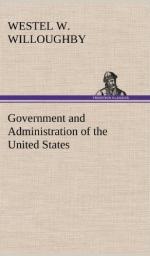_#The Expenditures#_ of all the governing bodies, Federal, State, and local, are kept entirely independent of each other. Those of the Federal government are for the benefit of all the States, while those of the other bodies are only for their own individual benefit. The Federal government receives much more than it expends, and has yearly a surplus on hand in the Treasury. The States and local bodies have in the past expended more than their revenues, making up their deficiency by loans on their credit.
The chief objects of Federal expenditure (in addition to the postal system already considered and for the most part supported by its own revenue) are: 1st, interest on the public debt; 2d, pensions to disabled soldiers; 3d, for the support of the civil branch of the government; 4th, war and naval expenditures.
Total expenditures for the year 1889 were $299,288,988. The chief items were:
1. Interest on the public debt, $41,000,484 2. Pensions, 87,624,779 3. Civil service, 80,664,064 4. War and Navy, 65,815,079 5. Indians, 6,892,207
Money can be expended by the government only after it has been appropriated by Congress in its annual appropriation bills. The appropriation of supplies by Congress is the most important business that it transacts. Every year the heads of all the different departments frame estimates of the amounts of money needed to support their departments during the following year, which estimates they send to the Secretary of the Treasury, who, after considering and revising them, transmits them to Congress in his “Annual Letter.” This letter is considered by the Appropriation Committee, whose duty it is to consider and frame bills for the appropriation of moneys. Though guided by these estimates, supplies frequently depart widely from them. After being reported to the House and passed, money bills are sent to the Senate, where they are invariably amended by increasing the appropriations and are returned to the House. A conference committee is then appointed from the House and Senate Committees on Appropriations, who, after mutual concessions, agree upon such appropriations as will be passed by both houses. The House then amends the bill as agreed upon, passes it, and sends it to the Senate again, which in turn passes it, and sends it to the President for his signature. All bills for raising money must, by the Constitution, originate in the House. Besides the appropriations for the expenses of government there is annually authorized a large expenditure for improvement of rivers and harbors. Many of the expenditures authorized by these bills are undoubtedly unnecessary, but they are passed by general consent of the members, each of whom desires to increase his popularity at home by getting public money spent in his district.




